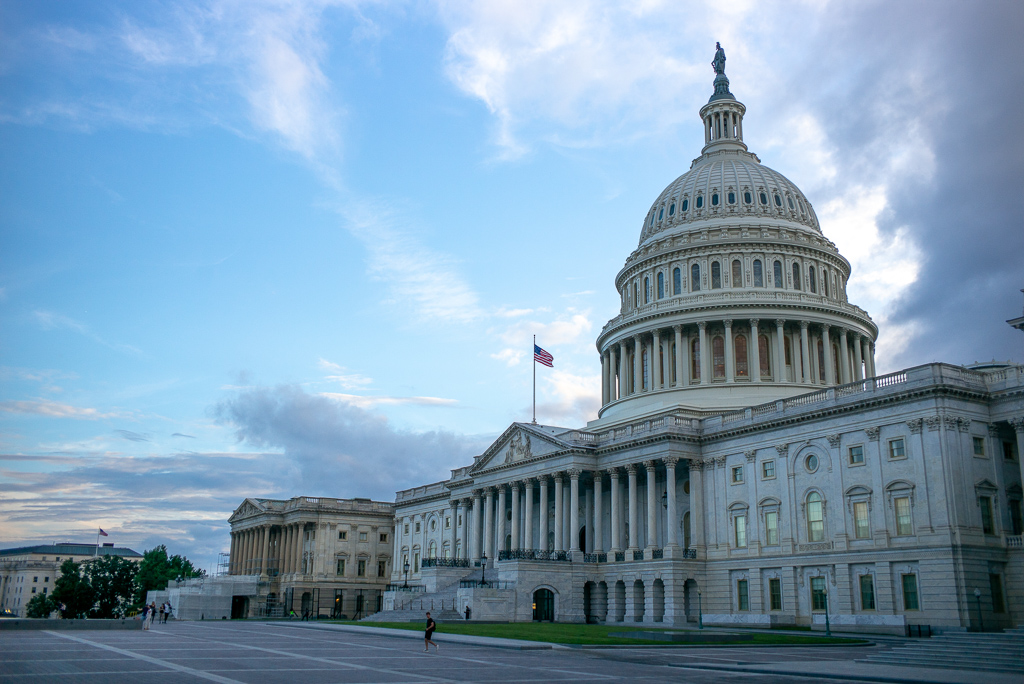The Battle For Senate Control In 2020 Appears To Favor Republicans
In the battle for Senate control in 2020, the conditions appear to favor Republicans. At least for now.

Axios reports that Senate Republicans appear to have the edge in the battle to control Congress’s upper chamber in 2020, and the battle could have very little connection to the outcome of the Presidential race:
The big picture: Republicans have a significant head start in the race to keep control of the Senate, per this group’s analysis.
- Because of their stronghold in rural areas, and based on previous presidential election results, the GOP has a 40-seat, “built-in base in the Senate.”
- Compare that to just 26 Senate seats that Democrats are best positioned to win.
- That’s prompting some Democrats — like former North Dakota Sen. Heidi Heitkamp, who’s a founding member of One Country Project — to sound the alarm ahead of 2020.
“[U]nless we do a better job engaging rural Americans, Republicans will have a massive head start in every race for a Senate majority and a lock on enough seats to stand in the way of a Democratic president’s agenda,” Heitkamp said. “If nothing changes, Democrats will never have more than a hope and a prayer of eking out a slim Senate majority — at best.”
By the numbers: Those “built-in” advantages are based on each party’s “base” states, where they won the presidential vote by 10 percentage points or more in the last election.
- Democrats won 13 states by that measure in 2016, which translates to 26 Senate seats.
- Republicans won 20 states by that measure, which gives them an advantage in 40 Senate races.
- In 2020, there are 22 Republican incumbents up for re-election compared to just 12 Democratic senators.
Conventional wisdom says that the GOP should be more vulnerable given those numbers. But since these Republican incumbents mostly come from states that heavily support President Trump — and considering Senate results increasingly match presidential results — this could pose another challenge for Democrats.
Heading into the 2020 elections, there’s been at least some hope that the Senate landscape would be better for Democrats than it has been in the past several elections, which saw Republicans gain control in 2014, hold onto it in 2016, and gain seats in 2018 notwithstanding the fact that a Democratic wave caused the House of Representatives to change hands for the first time in nearly a decade. Because of this, the Senate elections in 2020 will include far more seats held by Republicans than we have seen in the past, including several that could change hands from Republican to Democratic depending on how the election goes.
As Axios notes, though, the map is looking far less favorable for Democrats than it may have seemed just a few months ago. Of the seats that are up, there are four seats that seem the most likely to be elections in which the opposition party could end up picking up a seat. Three of tbose races are being held in Republican-held districts, and one is a Democratic seat:
In this election, Martha McSally, who was appointed to fill the remainder of the term of the late John McCain, is seeking to win the seat in her own right. She is principally being opposed by former Astronaut Mark Kelly, the husband of former Congresswoman Gabby Giffords, who is running in the Democratic primary.
In the Centennial State, freshman Senator Cory Gardner is seeking re-election in a state that he narrowly won over former Senator Mark Udall. This tie around, there are more than a dozen declared Democratic candidates but some state Democrats are hoping the former Governor John Hickenlooper, who is currently running for the Democratic Presidential nomination, will abandon his increasingly quixotic campaign for President in favor of running for President. So far, though, Hickenlooper has resisted such calls.
This seat could make for an interesting race simply because incumbent Senator Lamar Alexander is retiring rather than running for re-election. So far, the race is wide-open on both the Republican and Democratic sides of the aisle and it will likely be several months before anything is clear.
This, of course, is the Democratic-held seat that Republicans are most likely to return to the red column next year. Incumbent Senator Doug Jones, who does face a primary challenge next year, won the seat in a Special Election in December 2017 due largely to the controversy surrounding his opponent, former Chief Justice of Alabama’s Supreme Court Roy Moore. Moore is a candidate for the Republican nomination again, but the odds that he’ll be able to repeat the win he managed two years ago is unlikely. It is also a state that President Trump won easily in 2016 and which he will win again in 2020. Given that, and assuming the Republican nominee is anyone other than Moore, this seems like an easy Republican pickup which could offset Democratic gains elsewhere in the country.
Right now, of course, Republicans have a 53-47 majority in the Senate, this means that they could afford to lose as many as three seats (net) and still retain control of the upper chamber of Congress. Unless additional opportunities open up for Democrats, it seems as if that’s exactly what’s going to happen.



Itwas always going to be a tough hill for DEMs to climb.
This is once again why all the predictions of the demographic death of the Republican party are so overblown. The reality is that the fact that, geographically speaking, the majority of the county (if not where the majority of the population lives) is rural means that the Republican party doesn’t need to change anything so long as they still are well entrenched in rural areas.
I’m surprised you’re counting Tennessee as a possible switch, but not Maine.
I would put North Carolina as as likely a switch as Tennessee as well (that is to say, both states are favored to go Republican, but Dems have a middling-to-decent chance of prevailing).
@Neil Hudelson:
Agreed. Collin’s — if she runs — seems like she is in a much more vulnerable position. I’m not sure she can earn enough “independent” bona-fides in the next year to keep that seat secure (especially as the Dem’s candidate seems pretty strong – https://www.cnbc.com/2019/06/24/sara-gideon-challenges-susan-collins-in-2020-maine-senate-race.html ).
@Neil Hudelson:
Until we know what Collins is going to do I don’t think we can say anything about Maine.
If she runs for re-election, I think she’ll survive just as she has in the past.
@Doug Mataconis:
She’s a fighter, for sure. But she has some work to do:
https://nymag.com/intelligencer/2019/07/susan-collins-approval-rating-dives-as-2020-approaches.html
Maine…my friends there tell me that Collins won’t run because if she does, she will lose. Maine is more blue than purple, today…and her total cave on women’s rights basically finished her.
Kentucky…yeah, of course, Moscow Mitch is going to win…again…but friends in that state say he’s in as much trouble as he’s ever been. And McGrath is a strong candidate who is working hard.
@Daryl and his brother Darryl:
If there’s a true wave/repudiation of Trump (I don’t see one forming yet), then I think Maine, AZ, CO, and NC go Dem, and Dems have a real shot of unseating Mitch (and maaaaaaaaaaaybe keeping Alabama IF Moore is GOP candidate again).
Outside of a wave, McConnell is going to hold on to that seat, and Thillis likely holds on to NC. Doug Jones will have no shot in AL.
@Neil Hudelson:
Neither do I, but I think it’s early for that?
If there is a going to be a wave, Leningrad Lindsey may be in trouble, too.
@Neil Hudelson:
If 2020 becomes an election about change, then we will see a wave that I expect would bring in a Democratic Senate.
Typically, “direction of the country” unfavorables hinge on economic indicators. Since there are signs of a possible recession and the tariffs are causing turmoil, a change in economic direction may drive 2020 elections.
I believe Trump creates another possible motivation for a change election. The bases are dug in, but I’ve got to figure Independents are sick and tired of the constant drumbeat of ineptitude and scandal that has become the norm under Trump. That could drive for a change election as well.
If it’s not a change election, the Republicans will certainly hold the Senate and I’d expect Trump to win again, too. If the electorate is okay with this abhorrent status quo, then I guess we are truly screwed.
@Neil Hudelson:
If there isn’t a wave, given all the gifts Trump keeps handing the Dems, then Democrats need to find a new line of business. The only way that a wave doesn’t develop is if people are so beaten down and worn out that they stay home. I like the way Beto has responded to El Paso the last few days. More people need to be furious and fired up.
First of all, I believe Susan Collins in Maine and Cory Gardner in Colorado are both in serious trouble. Once a popular Senator in her state, Collins’ approval ratings have totally crashed since the Kavanaugh vote; they sit at 45/48 currently according to Morning Consult. Gardner is at 37/37. Both are in states that Hillary Clinton won in 2016. By no means am I saying that unseating them will be a slam dunk. Dems need to get good candidates and invest a lot of resources into it. But personally, I think both Senators are underdogs at this point.
Next is AZ’s Martha McSally, who lost to Kirsten Sinema last year and then was appointed to McCain’s seat by the governor. Her ratings are a mediocre 40/37. The top Democratic candidate is Mark Kelly, former astronaut and husband of former Congresswoman Gabby Giffords, who held a Republican-leaning district before the 2011 attempt on her life.
If Dems win the presidency next year and win all three of the above-mentioned seats–and don’t lose any other seats–then they will win control of the Senate.
Unfortunately, I think it’s highly likely Doug Jones is going to lose his Alabama seat. If Roy Moore becomes the nominee again he’s got a fighting chance, but it doesn’t look likely the Republicans are about to repeat that mistake.
But I think Dems have a good chance of defeating NC’s Thom Tillis, whose approval rating is 33/35. Like AZ, NC will be a battleground state at the presidential level in 2020. It was in 2016, and even though Hillary ended up losing it by 3 points, at the same time the state elected a Democratic governor who unseated the Republican governor.
I also think Dems have a chance of unseating Iowa’s Joni Ernst, whose ratings are at 42/38. Even though Iowa went strongly for Trump in 2016, Dems did well in it in 2018–though they didn’t quite unseat the incumbent Republican governor, they won three of the four Congressional districts and came surprisingly close to taking out Steve King, whose district is a lot more Republican than the state at large. The state has a history of being very fickle and swingy, especially when the farmers get hurt by Republican policy (it was Dukakis’s second-best state in 1988 after having voted Republican the four previous times).
There are other states where the Dems might have an outside chance: Texas, Georgia, Montana (especially if Bullock runs)–though in all those cases the incumbent Republican Senator has decent approval ratings. McConnell’s ratings in Kentucky are terrible as usual, but they also were back in 2014, when he won reelection by a wide margin. Kentucky’s so red that the voters will even prefer an odious turtle to any Democrat. (That’s true for the Senate, at least; I have more confidence that they can unseat Gov. Bevin this year.) Heck, maybe even Kansas (where there’s an open seat, following Pat Roberts’ decision to retire) could be in play if KKK (Kansas Kris Kobach) becomes the nominee.
Still, I don’t want to make it sound like I’m chasing unicorns. Just sticking to what’s plausible, winning CO, ME, AZ, and at least one of AL, NC, or IA strikes me as doable, albeit difficult.
I will say one thing: I don’t see a realistic scenario where Dems win the Senate at the same time as Trump wins reelection. Dems will need some coattails to achieve the former (in addition to needing an additional seat if a Republican is vp). On the other hand, Dems don’t necessarily need to win the same states as they do in the presidential contest. In 2012, for example, five Romney states voted for a Democrat for Senate, and one of them (Indiana) actually flipped from Republican to Democratic. In 2000, even while (sort of) losing the presidential election, they flipped two Senate seats in states that went for Bush.
In all this speculating, I am taking for granted that the current political mood next year remains more or less the same as it is now. I could see a scenario where the bottom totally falls out from under Trump, leading to a rout along the lines of 1980 or 2008, both of which led to surprise victories for the out-party in several Senate races. But that doesn’t need to happen in order for Dems to regain the Senate.
The issue with polls this early, is that voters don’t know how they’ll feel in October of next year. The economy may be in recession then. A disastrous war may be playing out in Iran or Venezuela, or, gods forbid, in the Korean peninsula. Impeachment proceedings may be going on in the House, or a trial at the Senate.
This holds even for voters who are certain they’ll vote the straight red Kool-Aid ticket come November, or, for that natter, to those who are certain they’ll vote Democratic across the board.
Yeah. The Dems need to flip three seats to tie, four if you don’t want to depend on winning the White House, five if you assume Doug Jones loses, and six if Manchin goes through with his threat to run for governor of WV instead (my acquaintances in WV tell me there’s no other Dem who can win that seat). My count in rough order is CO, ME, AZ, and then it gets very thin. IA maybe. NC maybe. MT maybe, if Bullock decides he’d rather be Senator than married (his wife has reportedly said, “Hell, no!” to a Senate run).
Myself, I think one of the biggest hurdles is that the DNC hates that flipping the AZ and NV seats in 2018 is the only reason there’s a chance, and the thought of winning on the basis of three more Mountain West seats makes them crazy.